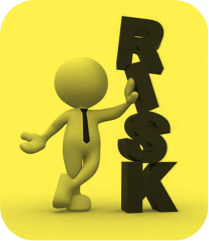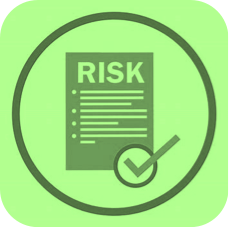RISK & UNCERTAINTY
Overview
Risk and Uncertainty
Value, performance, cost, risk and uncertainty are inextricably linked. As for value, risk is a term that can mean different things to different people. Generally, risk may be defined as the potential exposure to loss (or gain) through commercial or other activities. The distinction between risk and uncertainty is that risk is quantifiable, whereas uncertainty is not. Objective probability is the basis for risk, while subjective probability underlies uncertainty.

“Decisions are often made under conditions of uncertainty since it may be difficult to predict the response of an individual to an event. When decision-makers are faced with uncertainty, they will react according to their nature. Some will assume the worst; others will hope for the best. In the former case, the individual is more concerned with possible future loss in a disaster than with actual gains. Most decision-makers are in the centreground—partial optimists”.
Source: Geographical Dictionary
During the policy, program or project development process, a particular risk and uncertainty can be lack of stakeholder agreement on needs and proposals. This can derail the approval process and incur significant delays in project development and subsequent implementation.
Risk and uncertainty are present in quite different forms for various levels of project authority and implementation personnel. Risk may be stated as any potentially detrimental occurrence to a project in terms of cost, schedule, safety, quality, reliability, stakeholder disruption, etc. In the “bigger picture”, risks and values may relate to societal health and wellbeing, ecology, social issues, litigation, politics or other parameters. For example, risk may be related to failure to protect public health or to the economic downfall of a region.
Risk
An understanding of risk and formal ways to manage uncertainty is being seen increasingly as an essential part of smart business and project management. Risk management is categorized as and applied to: portfolio / enterprise, projects, and multiple projects / program.
During the policy, program or project development process, a particular risk and uncertainty can be lack of stakeholder agreement on needs and proposals. This can derail the approval process and incur significant delays in project development and subsequent implementation. In some jurisdictions, risk may be negative or positive (i.e. opportunity).

Risk is a term that can mean different things to different people. Generally, risk may be defined as the potential exposure to loss (or gain) through commercial or other activities. The distinction between risk and uncertainty is that risk is quantifiable, whereas uncertainty is not.
Sound risk management practices play an important role in achieving organizational goals and objectives. By adapting the traditional project risk management methodology, enterprise risk management (ERM) provides a decision process for managing uncertainty at the portfolio level as well as ensuring a defensible basis for policy and resource allocation. Identification and proactive addressing of strategic risks and opportunities helps organizations to create and protect value for their various stakeholders. A risk management system identifies: areas with inadequate control measures; documents risk mitigation plans and responsibilities; tracks the progress of outstanding action plans and raises the ongoing awareness of management to key areas of concern.
Recent major financial events around the world have raised interest in risk management especially in the financial sector. As a result industry sectors and their senior management are, increasingly, required to review and report on the adequacy of risk-management processes in their organizations.
At the Roots of Risk

Risk and uncertainty are inherent in almost all undertakings. The extent of the risk and vulnerability of persons or organizations potentially impacted varies with circumstances and conditions. Small increases in capital, operational, maintenance and financing costs, combined with a small decrease in demand or revenue can turn a potentially profitable venture into a low-yield or loss-making situation.
Risks may:
❊ exist within the organization (accidents and process events)
❊ be transmitted by the organization (negligence, injury, environmental harm)
❊ arise from outside the organization (natural disasters / conditions, third party impacts)
Risks may be present due to limited experience, lack of information and general uncertainty regarding future conditions and viewpoints. Risks may also occur as parties, personnel and relationships change during the course of a long duration project. Risk and uncertainty may generally be categorized as arising internally or externally. Internal uncertainty may relate to business aims, scheduling, resourcing, etc. External uncertainty, which is usually more difficult to deal with, may relate to regulatory approvals, land acquisition, politics, environmental opposition, economic trends, etc.
In construction, risks often relate to costly unknown conditions such as poor ground, old buried structures, archaeological remains, future exchange rates, labor disputes etc. During the project operational lifetime there may be significant risk of the project not performing as required (e.g. through technical failure or inaccurate data). Ultimately, the organization is at risk of loss or damage in terms of financial standing, ability to perform and image or reputation.
Uncertainty

In particular, accuracy of projections can lead to a major area of uncertainty. Typically, historical trends are plotted and then a range of projections is added. It is wise to define both upper and lower bound solutions, together with their corresponding base assumptions. There is usually a large spread between the two extreme limits, thus indicating the implications of adopting an unrealistic prediction and the related staging and cost implications. Such basic assumptions are often quite controversial and have major impacts on planning appropriate lead times, resources and budgetary requirements. Examples include major facilities such as airport terminals, rail lines, highways, water networks, criminal courts, prisons, hospitals, manufacturing plants, housing stock, power plants, regional irrigation systems, etc.
Significant uncertainties are likely to be encountered in estimating scheme benefits and costs. To address this, quantitative uncertainty analysis may be used to compare relative benefits and costs. Techniques range from parametric analysis of critical assumptions to probabilistic techniques (such as those based on Monte Carlo Analysis ). This uncertainty treatment is particularly important as there can be considerable extra or unexpected costs associated with a decision that is based upon an analysis that would otherwise have significant levels of inherent uncertainty.
Balanced Approach

While neglect to identify a risk can be expensive, so can unnecessary allowance to avoid each and every possible risk that may be foreseen. Further, once identified, risk may be examined creatively and turned into a scheduling or economic opportunity.
A balanced approach is advocated to identifying and specifying methods to address risks. At the early needs analysis and concept / feasibility stages there are the two particular contrasting issues of:
- rationalizing applied safety margins, redundancy of processes or units and a diversity in design approach
- providing for "over design" to allow "operational comfort" and thereby increasing life cycle costs.
Risk management provides a rigorous and comprehensive formal structure for planning, developing and implementing strategies and initiatives. The process of risk management starts early in the life of a program or project and continues through various iterations that focus on different aspects of the life of the program / project. Risk management is applied across the complete life cycle of an investment, asset or service. It systematically identifies, assesses and removes or reduces the uncertainties and related impacts that threaten the accomplishment of project objectives.
There are different risk management protocols issued by various authoritative bodies.
The EVOLVE Performance & Cost Optimization process is the guiding framework for ensuring best overall value and systems resiliency – at different levels of the enterprise. The process provides a mechanism for increasing general awareness of potential hazards, reducing adverse effects and enhancing effectiveness and profitability.


